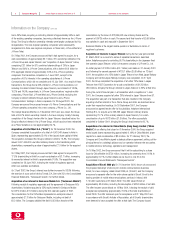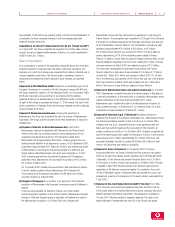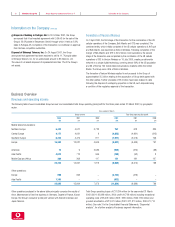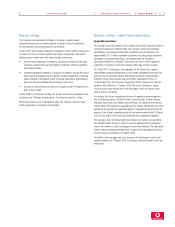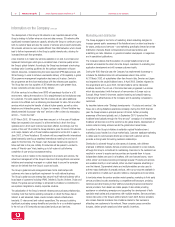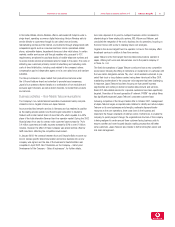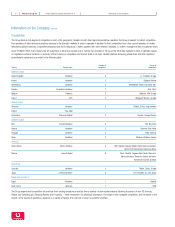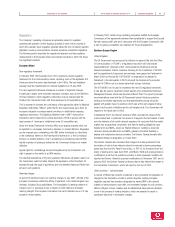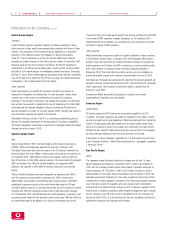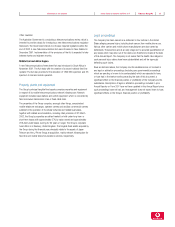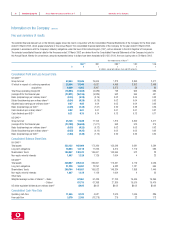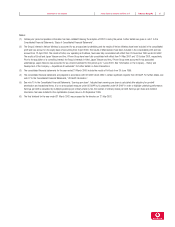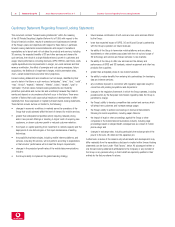Vodafone 2002 Annual Report Download - page 20
Download and view the complete annual report
Please find page 20 of the 2002 Vodafone annual report below. You can navigate through the pages in the report by either clicking on the pages listed below, or by using the keyword search tool below to find specific information within the annual report.
Vodafone Group Plc Annual Report & Accounts and Form 20-F Information on the Company18
to China Mobile’s board of directors. The subscription is expected to complete
in June 2002.
At 31 March 2002, China Mobile had approximately 74,402,000 registered
customers and is the second largest mobile telecommunications company in
the world, after the Company, in terms of number of proportionate registered
customers.
Australia and New Zealand
Network operations in Australia and New Zealand, both of which operate under
the Vodafone brand name, increased their registered customer base by an
aggregate 8% in the 2002 financial year, ending the year with 3,241,000
registered venture customers.
Australia and New Zealand operate digital networks based on the GSM technical
standard, providing coverage to approximately 92% and 97% of the population,
respectively. The digital network in Australia consists of approximately 2,085
operational base stations, 16 base station controllers and 12 mobile switching
centres. In New Zealand, the digital network consists of approximately 695
operational base stations that are controlled by 24 base station controllers and
are managed by 5 mobile switching centres.
In Australia, which is a highly competitive market with five mobile networks,
Vodafone’s customer base increased by 35,000 net new customers, giving a
market share of approximately 17%, compared with 19% at 31 March 2001.
In New Zealand, strong growth continued with an 23% increase in the registered
customer base to 1,095,000.
Australia and New Zealand acquired 3G spectrum for A$254 million (£87 million)
and NZ$29 million (£8 million), respectively, in recent auctions conducted in
these countries and both expect to introduce 3G services by 2004, to coincide
with the expected mass-market availability of dual-mode handsets.
On 22 June 2001, the Group announced that it had acquired an interest in
97.8% of the share capital of Mobile Communications Holdings Limited (“MCH”)
and, in accordance with the terms of the agreement, has since acquired the
remaining MCH shares. MCH held an interest in 4.5% of the Group’s Australian
subsidiary, Vodafone Pacific Limited. As a result of the transaction, the Group’s
effective interest in its Australian operations increased from 91% to 95.5%.
On 3 May 2002, the Group completed its purchase of the remaining 4.5%
minority interest in Vodafone Pacific Limited, as a result of which Vodafone
Pacific Limited became a wholly owned subsidiary undertaking.
Middle East and Africa
The Group’s operations and ownership interests in the Middle East and Africa
Region comprise Vodafone Egypt Telecommunications Company SAE (“Vodafone
Egypt”) (60%), Safaricom Limited in Kenya (30%) and Vodacom Group (Pty) Limited
in South Africa (31.5%).
The closing registered customer base of the ventures in the Middle East and
Africa region increased to 8,715,000 at 31 March 2002, which represents
growth of 37% on the closing registered customer base at 31 March 2001.
Egypt
Vodafone Egypt is Egypt’s second largest mobile operator, and operates under
the brand name Vodafone. Since its launch in November 1998, it has increased
the number of customers connected to its network to approximately 1,718,000
by 31 March 2002.
In Egypt, Vodafone offers both contract and prepaid services, with prepaid
customers representing approximately 87% of the customer base.
On 2 May 2002, Vivendi Telecom International notified the Group that, pursuant
to a put option agreement, it is required to purchase 8,400,000 shares in
Vodafone Egypt. As a result of the transaction, the Group’s interest in Vodafone
Egypt will increase from 60% to 67%.
South Africa
Vodacom is South Africa’s largest mobile operator. Its customer base increased
by 28% in the 2002 financial year to over 6,557,000 registered customers, of
whom approximately 83% are connected to the prepaid service, Vodago.
Vodacom also has a licence to operate in Tanzania where it launched services in
August 2000. During the 2002 financial year, Vodacom continued to expand into
Africa and, in December 2001, formed a joint venture in the Democratic Republic
of the Congo.
Kenya
Safaricom is the largest operator in Kenya, having a market share of 58% and
registered customer base of 440,000 at 31 March 2002.
Mobile data services
Revenue streams from messaging data and internet data services (“data
revenues”) increased 87% to £2,093 million for the 2002 financial year, and
represented over 11% of service revenues in the Group’s controlled subsidiaries
during the year. For the month of March 2002, data revenues as a percentage of
service revenues increased to over 13%.
These results include, for the first time, a contribution from GPRS services, which
have now been launched in almost all of the Group’s major markets. The Group
expects that the “always-on”feature of GPRS handsets, combined with colour
screens and a generally wider choice of handsets, will accelerate the take-up
and usage of data services, including internet-based services.
During the 2002 financial year, the Group has amended its target for data
revenues. Previously, the target was to derive between 20% and 25% of service
revenues from data services by March 2004. However, due to a combination of
better than expected levels of voice revenues and delays in the availability of
GPRS applications and terminals, the target has been revised to achieve 20% of
service revenues from data services in 2004.
Further details on the Group’s strategy and plans for the development of data
services can be found in “Strategic developments – Products and services”,
below.
Third generation licences and network infrastructure
The Group has secured 3G licences in all jurisdictions in which it operates and in
which such licences have been awarded to date. Further details can be found in
“Information on the Company – Business Overview – Business Activities –
Mobile Telecommunications” above.
Cumulative expenditure on 3G licences was £13.4 billion at 31 March 2002
and was funded from the Group’s existing borrowing facilities. Most of this
expenditure (£13.1 billion) occurred during the 2001 financial year. During the
2002 financial year, the Group spent £325 million on intangible fixed assets,
including the acquisition of a further two 3G licences, in Greece and Australia,
Information on the Company continued


